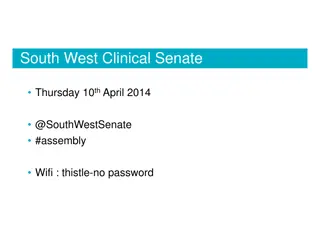
California's Healthcare Landscape Before the ACA
Explore the healthcare scenario in California pre-Affordable Care Act (ACA) implementation, highlighting high uninsured rates, limited access, and challenges faced by residents in obtaining affordable coverage.
Download Presentation

Please find below an Image/Link to download the presentation.
The content on the website is provided AS IS for your information and personal use only. It may not be sold, licensed, or shared on other websites without obtaining consent from the author. If you encounter any issues during the download, it is possible that the publisher has removed the file from their server.
You are allowed to download the files provided on this website for personal or commercial use, subject to the condition that they are used lawfully. All files are the property of their respective owners.
The content on the website is provided AS IS for your information and personal use only. It may not be sold, licensed, or shared on other websites without obtaining consent from the author.
E N D
Presentation Transcript
Senate Health Committee The Affordable Care Act in California: What s at Stake January 19, 2017 Deborah Kelch Executive Director Insure the Uninsured Project
Who We Are Insured the Uninsured Project (ITUP) Nonpartisan, independent 501 (c)(3) organization Founded in 1996 after failure of federal health reform ITUP s mission is to advance creative and workable policy solutions that expand health care access and improve the health of Californians ITUP implements its mission through policy-focused research and broad- based stakeholder engagement 2
Summary Main Points Overview of pre-Affordable Care Act (ACA) coverage and markets Highlights of California s ACA implementation What s At Stake for California 3
CA Before ACA High rates of uninsured hovering around 20% for decades 6.5 to 7 million uninsured Californians in 2013 Employer-sponsored coverage was declining with employees paying a higher share of costs Individual coverage was not available to people with pre- existing conditions; Coverage priced out of reach for most low- and moderate income Californians Many Californians had low-benefit, low-value coverage with high premiums Medi-Cal was only available to children, seniors and disabled, and some low-income parents 4
Medi-Cal Pre-ACA 2012-13: 7.9 million enrolled Eligibility tied to income but also based on other factors: Children and some parents of children Pregnant women Seniors and qualifying persons with disabilities Working adults without children were not eligible regardless of income Complex enrollment system with limited application entry points and inadequate application assistance 5
Pre-ACA Insurance market Pre-ACA Individual Market characteristics Coverage denied based on pre-existing health issues such as cancer, HIV/AIDs, other life-threatening illnesses and even common conditions such as diabetes, hay fever, etc. Coverage availability at insurer discretion Rates higher for those with health issues or claims history if they could get coverage California administered a high-risk pool for people who had been denied individual coverage. State struggled to fund the program, plagued with waiting lists, expensive for enrollees and capped benefits ($75,000 per year) 6
Private Insurance Market Pre-ACA Individual Market Many policies with limited benefits and inadequate coverage no minimum value standard Annual and lifetime dollar limits on benefits No limits on consumer out-of-pocket costs Premium rates not publicly available; Limited regulatory review of rates and rate increases 7
Private Insurance market Pre-ACA Individual Market characteristics Two state regulators with very different coverage and benefit standards Department of Insurance Policies might only cover hospital and limited office visits Fixed dollar and service limits e.g., number of hospital days No requirement to cover all medically necessary services Department of Managed Health Care Coverage Medically necessary basic services doctors, hospitals, lab/X-ray, etc. Prescription drug coverage not mandatory Hard for consumers to understand or compare coverage 8
ACA in California California embraced the ACA soon after passage (2010) Enacted the first law in the country to create an ACA marketplace (exchange) with California-specific enhancements (Covered California) Passed and improved ACA insurance reforms for the individual and small employer markets Expanded Medi-Cal eligibility to the maximum allowed under the ACA and covered all low-income children Invested in statewide marketing, outreach and enrollment assistance to enroll Californians in Medi-Cal and Covered California 9
ACA in California Dramatic Reduction in Number of Uninsured in CA Pre-ACA (2013) 6.5 - 7 million uninsured With ACA (2015) 3 - 3.5 million uninsured (8-9%) The largest reduction in the uninsured of any state Overall Medi-Cal enrollment increased dramatically; the ACA coverage expansion added 3.9 million beneficiaries Covered California enrolled 1.4 million 10
Medi-Cal under ACA Post-ACA Medi-Cal Program 2017-18: Governor s Budget projects 14.3 million Californians will be enrolled in Medi-Cal Universal coverage for citizen and lawful resident Californians under 138% of the federal poverty level Covers children and pregnant women at higher incomes; Covers all low-income children, regardless of immigration status More than one-third of Californians and 60% of California children covered by Medi-Cal Improved eligibility and enrollment assistance; Streamlined and online applications Expanded coverage for mental health and substance use disorder (SUD) treatment 11
ACA in California Private Insurance Markets Level of employer coverage has stabilized Individual and small employer coverage guaranteed regardless of health status or pre-existing condition No limits on coverage because of pre-existing conditions Children can stay on parent coverage until age 26 12
ACA in California Consistent Standards Regardless of Regulator No annual and lifetime dollar limits for coverage Annual limits on consumer out-of-pocket costs Individual and small employer plans -- Minimum coverage of medically necessary services Essential health benefits include coverage for prescription drugs, prenatal care, mental health and SUD treatment No cost sharing for preventive services Annual premium rate filings and rate review Rates based solely on age and geography 13
ACA Marketplace in CA Covered California Created an exchange that is an active purchaser, negotiating with health plans on behalf of its enrollees Subsidized premiums and cost sharing up to 400% federal poverty level with 90% of enrollees receiving subsidies Allowed Covered California to standardize benefits to help consumers comparison shop and required the same standard products in the outside market Online application and eligibility portal for Covered California and Medi- Cal California went beyond federal law to establish a viable and robust private market imposing consistent rules on coverage inside and outside of Covered California 14
Large Employer Coverage Many ACA Consumer Protections Also Apply to Large Employer Coverage No cost sharing for preventive services No annual or lifetime limits on coverage Limit on annual out-of-pocket costs Adult children stay on parents coverage until age 26 Right to external review of health plan coverage decisions No waiting periods to be covered under employer plan Benefits that meet a minimum value of 60% 15
Whats At Stake Details of ACA repeal and replacement unknown but what s at stake for California? Coverage expansions Federal funds for Medi-Cal and Covered California may be reduced or eliminated Individuals could once again be denied coverage or charged higher rates based on health status Insurance markets could be disrupted and consumer protections could be compromised or eliminated Depending on federal action, some of California s implementing laws could be automatically repealed within 12 months or become unenforceable 16
Potential Federal Action 2015 Budget Reconciliation (H.R. 3762): Restricted the federal government from operating health care exchanges Phased out premium subsidies through the health care exchanges Eliminated mandate tax penalties for individuals and employers Eliminated taxes on medical devices and the Cadillac tax on the most expensive health care plans Phased out the expansion of Medicaid over a two-year period 17
Whats Next Federal repeal and replace or repeal and delay still unknown Multiple proposals and approaches emerging ITUP believes that California can and should still lead the nation in expanding accessing and improving the health of Californians ITUP will monitor issues and events and remain a resource to California health care leaders and policymakers to meet the challenge 18
QUESTIONS 19






















